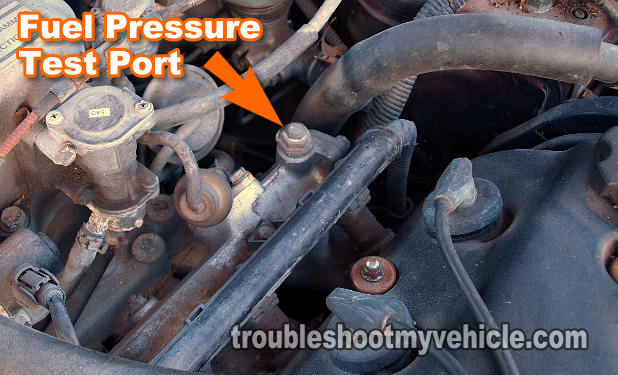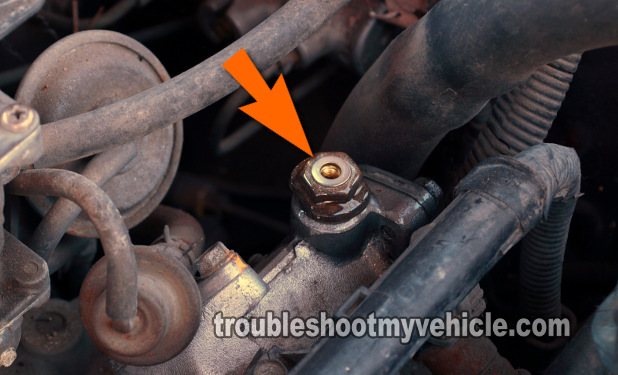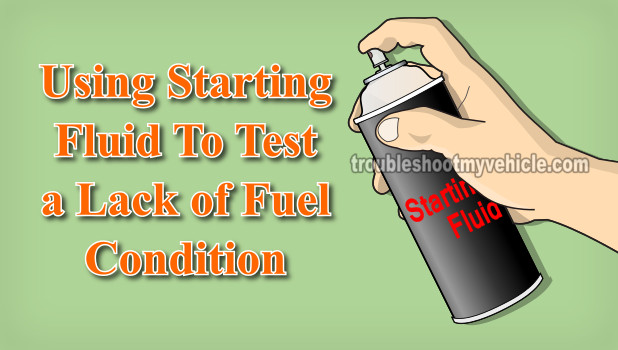
Making sure the fuel pump is really fried, before you replace it, is easy to do on your Honda Accord (or Odyssey or Prelude or Isuzu Oasis) and I'll show you how in this step-by-step article.
I'm gonna' present to you two different ways of diagnosing a no-start condition due to a lack of fuel. One is done with just starting fluid and the other is using a fuel pressure gauge. Both methods are effective, but only one is truly 100% accurate.
Contents of this tutorial:
Before you jump into any of these two tests, it's important to always keep in mind that gasoline is extremely flammable. You gotta be very careful around it. These tests can be safely done and without any complications if you think safety all the time.
Symptoms Of A Bad Fuel Pump
The most obvious symptom is that your Honda Accord (or Odyssey or Prelude or Isuzu Oasis) will crank but not start. Here are some more specific issues related to this problem:
- You've done a broken timing belt test, and it's not the timing belt.
- You tested for spark at every spark plug wire and there's spark being fired off at every single one, so you know it's not the ignition system.
- You've done a fuel injector Noid light test, and all four fuel injectors are getting both 12 Volts and the activation signal.
Although the above list is a not a very complete list of symptoms, the theme that runs thru' them, and any other related symptom, is that the engine will crank and crank, but not start.
Where To Buy A Fuel Pressure Gauge And Save
The following two fuel pressure gauge test kits include the adapter you'll need to check the fuel pressure on your Honda vehicle. And the best part of all, they're not going to break the bank:
Disclosure: As an Amazon Associate, I earn from qualifying purchases. If my tutorials help you, using these links is an easy way to support the site at no extra cost to you. Thank you!
TEST 1: Fuel Pressure Gauge Test

This test is for the serious do-it-yourself'er, since it involves using a professional level fuel pressure gauge. Using a fuel pressure gauge guarantees an accurate result.
Now, in case you don't own a fuel pressure gauge that has the adapter needed for your Honda Accord (or Odyssey or Prelude), you can check out some of my recommendations on which fuel pressure gauge set to buy and where to buy it: Where To Buy A Fuel Pressure Gauge And Save.
These are the test steps:
- 1
Locate the fuel pressure test port on the fuel injector rail.
NOTE: The photo above shows this location. - 2
Remove the screw from the fuel pressure test port.
- 3
Screw in the appropriate adapter from your selection of brass fittings in your fuel pressure gauge set.
- 4
Connect the fuel pressure gauge to this fitting.
- 5
Have your helper crank the engine while you observe the fuel pressure gauge.
- 6
You're going to get one of two possible results:
1.) The fuel pressure gauge will register 30 PSI, or
2.) The fuel pressure gauge will register 0 PSI.
OK, now that the testing part is done, let's take a look at what your results mean:
CASE 1: Your fuel pressure gauge indicated 0 PSI. This confirms that the fuel pump is not activating and supplying fuel to the fuel Injectors.
Now, what I have always done (since I always want to be absolutely sure about my diagnostic and this is my suggestion to you too) is to have someone crank the car while I check the fuel pump is getting power (12 Volts) with a multimeter.
The fuel pump on these Honda's can be reached thru' an access hole in the back of the car and the wiring that goes to it too. This is where I tap into the circuit that delivers the juice to the fuel pump. If when the car is cranking, and 12 Volts are present, then I know beyond a shadow of a doubt that I can replace the fuel pump and this will solve the no-start due to a lack of fuel condition.
CASE 2: The fuel pressure gauge registered 35 PSI while the engine was cranking. This test result lets you know that the fuel pump is working and is delivering enough fuel to the fuel injectors.
This result has also eliminated the fuel pump as the cause of your Honda's no-start condition. Now, since your Honda is still not starting, I suggest you test a couple of other things, such as the ignition system, timing belt, etc. You can find these specific 'how-to' tutorials I've written under the heading Related Articles at the end of this article.
TEST 2: Using Starting Fluid

The first test I'm gonna' explain is the easiest one to do, although it's not the most accurate. Now, although it's not the most accurate, you'll be able to confidently say that the no-start condition of your Honda is due to a lack of fuel.
This test is done with a can of starting fluid being sprayed down the Honda's engine throttle body.
IMPORTANT: You must first verify that your Honda's ignition system must be producing spark. This is important, since if there's no spark, this test is useless and, more importantly, indicates that the cause of the no-start condition is not due to a lack of fuel.
OK, enough yakking, here's what you'll need to do:
- 1
Remove the intake air rubber duct from the throttle body.
NOTE: The end that connects to the air filter box can remain connected to it. - 2
Manually open the throttle and spray starting fluid down the bore .
- 3
Reconnect the air duct to the throttle body.
NOTE: You don't need to tighten intake air duct's the hose clamp. - 4
Now, have your helper crank the engine.
- 5
One of two things is gonna happen:
1.) The engine will start, even if it's just momentarily or for a few seconds and then die or.
2.) The engine will only crank but not start at all.
OK, let's make sense of your test results in little more detail choose one of the two CASES below:
CASE 1: The engine started, even momentarily. This let's you know that the reason your Honda is not starting is due to a lack of fuel issue.
OK, now for a word of caution: In about 80% of the cases, you could condemn the fuel pump as bad, replace it and voilà, the problem is solved. 20% of the time it could be another issue.
This issues range from a blown fuel pump fuse, to a bad relay, etc. So, keeping this in mind, I suggest you do three more things:
- Check that the fuel injectors are getting both power and the activation signal (from the fuel injection computer) with a fuel injector Noid light.
- If the fuel injectors are not getting any one of these two signals, the fuel injectors are not going to inject fuel into the cylinders.
- Remove the fuel line that connects to the fuel injector rail (this is the one that delivers fuel from the fuel filter) and place it in a container. When ready, have your helper bump the starter motor while you verify if fuel comes out or not. No fuel coming out of the fuel line further confirms a bad fuel pump.
CASE 2: The engine did not start, not even momentarily. This tells you that the problem is not due to a lack of fuel. Now, keep in mind that this is not a 100% guaranteed way to check for a bad fuel pump, so I'm gonna' suggest that you do one more thing.
This is to remove the fuel line that connects to the fuel injector rail and place it in a container. Then have a helper bump the starter while you check to see if fuel comes out of the fuel line and into the container.
By doing this, you're visually making sure that there is fuel present and this further confirms that the no-start condition of your Honda is not due to a lack of fuel.
Related Test Articles
I have written several specific 2.2L and 2.3L Honda testing and troubleshooting articles that may be of further help. You can find the ones that are located here, at this site, by going to the Honda 2.2L, 2.3L Index Of Articles.
Here's a sample of the tutorials you'll find in the Honda 2.2L, 2.3L Index:
- How To Troubleshoot A No Start (Honda 2.2L, 2.3L).
- How To Test A Misfire Condition (Honda 2.2L, 2.3L).
- How To Test For A Bad Fuel Injector (Honda 2.2L, 2.3L).
- How To Test The Igniter, Ignition Coil, Spark Plug Wires, Distributor Cap (at: easyautodiagnostics.com).

If this info saved the day, buy me a beer!



